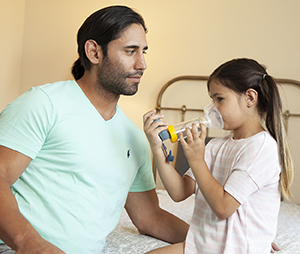Your child needs medicines to treat asthma. It's important to learn about out how they work, how they’re taken, and what their side effects are. Also make sure that your child is using the inhaler (and the spacer, if used) the right way. There are two types of medicines:
-
Long-term controller medicines. These reduce inflammation. They also keep airways from getting narrow. They are taken daily, even when your child feels well. They help keep symptoms from getting worse and prevent flare-ups.
-
Quick-relief (rescue) medicines. These treat flare-ups after they have started.
Medicines are a key part of your child's Asthma Action Plan. Talk with your child’s health care provider about making a plan if your child doesn't have one.
For long-term control
These medicines reduce the chance that a child will have to go to the ER or stay in the hospital.
-
They are not used to stop symptoms right away.
-
They must be taken every day, in many cases twice a day.
-
Your child may get biologic injections every few weeks. This may be done if other medicine doesn't control your child's symptoms.
Tips for taking controller medicines daily
Help your child know why they need to take medicine when they feel well. Try these tips:
-
Create a routine. Taking the medicines should be part of getting ready for bed or getting ready for school.
-
Set up a reward system. For example, award a point for each day your child sticks to the plan. Your child then earns rewards based on these points.
-
If your child is old enough, explain what long-term medicine does and doesn't do.
-
Talk to others, such as daycare workers and school nurses, about your child's medicines.
-
Don’t make any medicine changes without checking with your child’s health care provider.
Controller medicines your child may take
|
Medicine |
How it’s taken |
What it’s used for |
|
Inhaled corticosteroid |
Inhaler or nebulizer |
Controls airway inflammation. The first-choice for most kids with asthma. |
|
Other anti-inflammatory |
Inhaler or pills |
Helps control airway inflammation. Used for mild asthma or along with inhaled corticosteroids. |
|
Long-acting bronchodilator |
Inhaler or nebulizer |
Keeps muscles around the airways from getting tight. Used only with inhaled corticosteroids. |
|
Biologic |
Injection |
Helps with inflammation in the body. |
For relief of flare-ups
Know how to manage flare-ups. Learn your child’s symptoms so you can act quickly. This will help you stop flare-ups before they get bad. Follow your child's Asthma Action Plan. If your child doesn't have a plan or if the plan is not up-to-date, talk with their health care provider. The action plan may include:
-
Watching for symptoms and how to treat them.
-
Using quick-relief (rescue) medicine. This eases your child’s breathing right away.
-
Keep using or increasing controller medicine. This treats airway inflammation.
For flare-ups: Medicines your child may take
|
Medicine |
How it’s taken |
What it’s used for |
|
Short-acting bronchodilator |
Inhaler or nebulizer |
Gives quick relief. Relaxes the muscles around the airways. |
|
Oral corticosteroid |
Pills or liquid |
Taken for severe flare-ups. Reduces swelling and mucus in airways. |
Featured in


